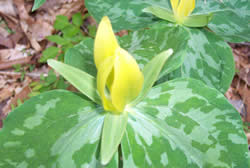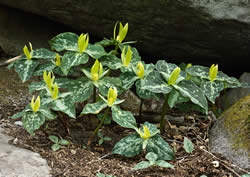Plant of the Week
 Trillium luteum range map. USDA PLANTS Database.
Trillium luteum range map. USDA PLANTS Database.
 Trillium luteum. Photo by Mark Pistrang.
Trillium luteum. Photo by Mark Pistrang.
 Trillium luteum. Photo by Mark Pistrang.
Trillium luteum. Photo by Mark Pistrang.
 Trillium luteum. Photo by Gayle P. Clement.
Trillium luteum. Photo by Gayle P. Clement.
Yellow Trillium (Trillium luteum)
by Mark Pistrang
All trillium species belong to the Liliaceae (lily) family and are rhizomatous herbs with unbranched stems. Trillium plants produce no true leaves or stems above ground. The “stem” is actually just an extension of the horizontal rhizome and produces tiny, scale like leaves (cataphylls). The above-ground plant is technically a flowering scape, and the leaf-like structures are actually bracts subtending the flower. Despite their morphological origins, the bracts have external and internal structure similar to that of a leaf, function in photosynthesis, and most authors refer to them as leaves.
Trilliums are generally divided into two major groups, pedicellate and sessile trilliums. In the pedicillate trilliums, the flower sits upon a pedicel that extends from the whorl of bracts. Either the flower may be “erect” above the bracts or “nodding” recurved under the bracts. In the sessile trilliums there is no pedicel and the flower appears to arise directly from the bracts.
Yellow trillium falls within the sessile group and typically flowers in April and May. Its twisted yellow petals distinguish it with a lemony fragrance. It can be found in deciduous forests, open woods, along rocky stream banks, and in rich mature forest on calcareous substrates. Yellow trillium was long considered a color morph of the more widely distributed Trillium cuneatum, but studies that are more recent have shown it to be a distinct species. Yellow trillium is found primarily in Tennessee, North Carolina, Georgia, and Kentucky. More northern occurrences (Michigan and Ontario) are attributed to “garden escapes” and are not a part of the natural range of this species.
For More Information
- PLANTS Profile - Trillium luteum, yellow trillium
- Flora North America: Trillium luteum
- Case, F.W., R.B. Case. 1997. Trilliums, Timber Press, Portland, OR.



